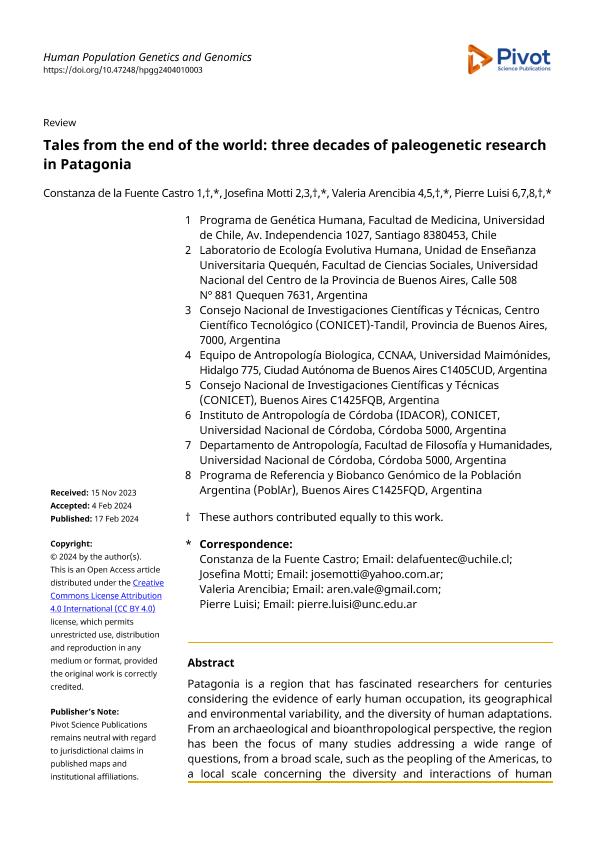Mostrar el registro sencillo del ítem
dc.contributor.author
de la Fuente Castro, Constanza
dc.contributor.author
Motti, Josefina María Brenda

dc.contributor.author
Arencibia, Valeria

dc.contributor.author
Luisi, Pierre

dc.date.available
2024-03-21T12:33:38Z
dc.date.issued
2024-02
dc.identifier.citation
de la Fuente Castro, Constanza; Motti, Josefina María Brenda; Arencibia, Valeria; Luisi, Pierre; Tales from the end of the world: three decades of paleogenetic research in Patagonia; Pivot Science; Human Population Genetics and Genomics; 4; 1; 2-2024; 1-34
dc.identifier.issn
2770-5005
dc.identifier.uri
http://hdl.handle.net/11336/231110
dc.description.abstract
Patagonia is a region that has fascinated researchers for centuries considering the evidence of early human occupation, its geographical and environmental variability, and the diversity of human adaptations. From an archaeological and bioanthropological perspective, the region has been the focus of many studies addressing a wide range of questions, from a broad scale, such as the peopling of the Americas, to a local scale concerning the diversity and interactions of human populations. For three decades, paleogenetic studies have contributed to the understanding of population dynamics in the region: first using uniparental markers, particularly mitochondrial DNA in a much larger proportion; and more recently including genome-wide data for ancient individuals. In this work, we revise these studies considering three themes: (1) the first stages of migration into the region; (2) the diversification and interactions of populations during the Middle and Late Holocene; and (3) the link between present-day and ancient populations. While genetic evidence from the early peopling stages is either absent or scarce, making it difficult to evaluate the relative contributions of early South American lineages in the first Patagonian populations, evidence from later periods (from Middle Holocene onwards) is consistent with a single migration wave with founding events and genetic drift acting on small groups during their migration southward. After the initial occupation, the population dynamics seem to have been characterised by the relative isolation of different groups, leading to their differentiation. While there is evidence of some degree of gene flow between groups, the genetic structure in the region is generally associated with geography, subsistence systems, and languages. After European contact, paleogenetic data supports a relative genetic continuity in the region. We finish this review with a fourth theme in which we reflect on the current state and direction of the field in Patagonia, highlighting research lines that will benefit from the implementation of state-of-the-art paleogenomic approach, as well as legal and ethical considerations that would allow to move forward into a more collaborative and inclusive field.
dc.format
application/pdf
dc.language.iso
eng
dc.publisher
Pivot Science
dc.rights
info:eu-repo/semantics/openAccess
dc.rights.uri
https://creativecommons.org/licenses/by/2.5/ar/
dc.subject
Paleogenetics
dc.subject
Ancient DNA
dc.subject
Uniparental lineages
dc.subject
Genome-wide data
dc.subject
South America
dc.subject
Human Population Genetics
dc.subject
Demography
dc.subject.classification
Otras Humanidades

dc.subject.classification
Otras Humanidades

dc.subject.classification
HUMANIDADES

dc.subject.classification
Otras Historia y Arqueología

dc.subject.classification
Historia y Arqueología

dc.subject.classification
HUMANIDADES

dc.subject.classification
Genética y Herencia

dc.subject.classification
Ciencias Biológicas

dc.subject.classification
CIENCIAS NATURALES Y EXACTAS

dc.title
Tales from the end of the world: three decades of paleogenetic research in Patagonia
dc.type
info:eu-repo/semantics/article
dc.type
info:ar-repo/semantics/artículo
dc.type
info:eu-repo/semantics/publishedVersion
dc.date.updated
2024-03-15T11:38:34Z
dc.journal.volume
4
dc.journal.number
1
dc.journal.pagination
1-34
dc.journal.pais
Estados Unidos

dc.description.fil
Fil: de la Fuente Castro, Constanza. Universidad de Chile.; Chile
dc.description.fil
Fil: Motti, Josefina María Brenda. Consejo Nacional de Investigaciones Científicas y Técnicas. Centro Científico Tecnológico Conicet - Tandil; Argentina. Universidad Nacional del Centro de la Provincia de Buenos Aires. Facultad de Ciencias Sociales. Departamento de Arqueología. Laboratorio de Ecología Evolutiva Humana (Sede Quequén); Argentina
dc.description.fil
Fil: Arencibia, Valeria. Consejo Nacional de Investigaciones Científicas y Técnicas; Argentina. Universidad Maimónides; Argentina
dc.description.fil
Fil: Luisi, Pierre. Consejo Nacional de Investigaciones Científicas y Técnicas. Centro Científico Tecnológico Conicet - Córdoba. Instituto de Antropología de Córdoba. Universidad Nacional de Córdoba. Facultad de Filosofía y Humanidades. Instituto de Antropología de Córdoba; Argentina. Programa de Referencia y Biobanco Genómico de la Población
Argentina; Argentina
dc.journal.title
Human Population Genetics and Genomics
dc.relation.alternativeid
info:eu-repo/semantics/altIdentifier/url/https://www.pivotscipub.com/hpgg/4/1/0003
dc.relation.alternativeid
info:eu-repo/semantics/altIdentifier/doi/https://doi.org/10.47248/hpgg2404010003
Archivos asociados
